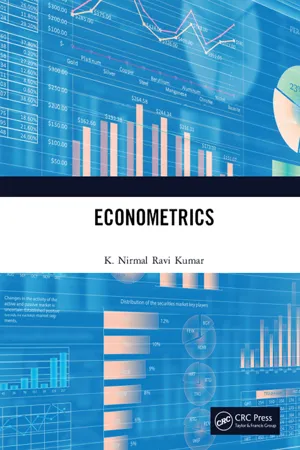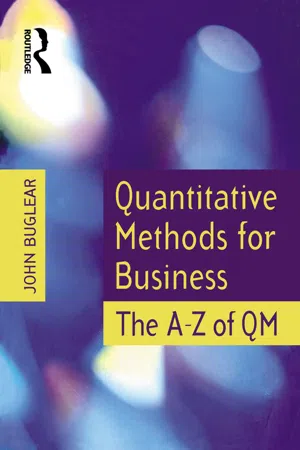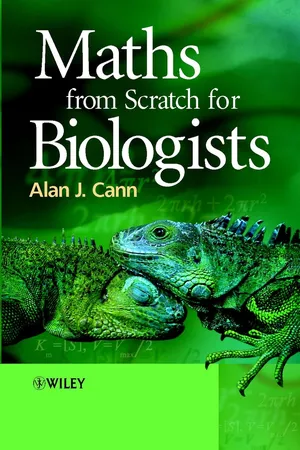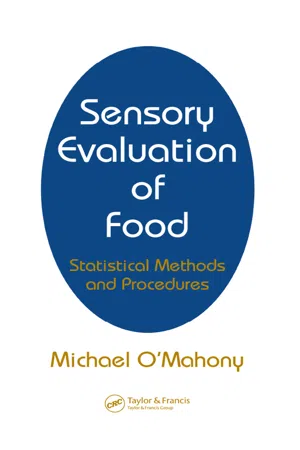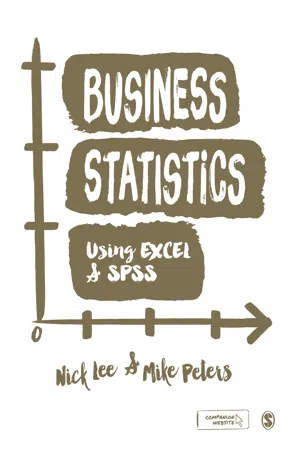Correlation and Regression
Correlation and regression are statistical techniques used to measure the relationship between two or more variables. Correlation assesses the strength and direction of the relationship, while regression helps to predict the value of one variable based on the value of another. These methods are commonly used in analyzing data and making predictions in various fields, including technology and engineering.
8 Key excerpts on "Correlation and Regression"
- eBook - ePub
- K. Nirmal Ravi Kumar(Author)
- 2020(Publication Date)
- CRC Press(Publisher)
...That is, the purpose of regression is to explain the variation in a variable (that is, how a variable differs from it’s mean value) using the variation in one or more other variables. Correlation studies the mutual dependence of variables i.e., it is two-way relation. Regression measures the functional relationship and analyses the extent of dependency of dependent variable on independent variable i.e., it is a one way relationship. Correlation is independent of both change in origin and scale of observations. Regression is independent of change in origin, but not of scale of observations. Correlation coefficient is a relative measure of linear relationship between the variables under consideration and is independent of measurement. Regression is an absolute measure showing the changes in value of Y due to X or the change in value of X due to Y In correlation, the variables are studied without any differentiation as dependent and independent variables. In regression, the variables are differentiated as dependent and independent variables. Correlation is symmetrical i.e. r xy = r yx and the value ‘r’ remains same Regression is asymmetrical in its relationship i.e.b yx ≠ b xy Correlation coefficient ranges from -1 to +1 Regression coefficient ranges from - ∞ to +∞ Correlation will not study the cause and effect relationship between the variables. Regression will study the cause (independent variable) and effect (dependent variable) relationship between the variables. Correlation coefficient is independent of units. Regression coefficient is in the units of dependent variable. Correlation has limited scope of application. It is limited to the linear relationship between the variables. Regression has greater scope in application...
- eBook - ePub
- Perumal Mariappan(Author)
- 2019(Publication Date)
- Chapman and Hall/CRC(Publisher)
...7 Correlation and Regression Analysis 7.1 Introduction We shall now study 2 (bivariate) or more variables (multivariate) simultaneously and attempt to find the relationship between the variables in quantitative or qualitative form. We have many such related variables, like crops per acre and fertilizer, height and weight, income and expenditure, etc. The credit of this methodology of studying the strength of relationships among the variables goes to Sir Francis Galton and Karl Pearson. 7.2 Correlation Correlation is a statistical measure used to evaluate the strength and degree of the relationship among the 2 or more variables under study. Here the term, ‘relationship’ is used to measure the tendency of the variables to move together. The movement of the variables may be in the same direction or in the opposite direction. The correlation is said to be positive if the variables are moving in the same direction and negative, if they are moving in the opposite direction. If there is no change in direction, it implies that the variables are not related. Correlation is classified into • simple correlation, • rank correlation, and • group correlation. 7.2.1 Simple Correlation or Correlation This measure can be evaluated in a discrete series of quantitative in nature. It is denoted by the notation r. The value of r lies in the closed interval (−1 ≤ r ≤ 1). If the value of r is toward 1, then variables are said to be positively correlated or directly related (if X increases, Y also increases, and if X decreases, Y also decreases). If it is toward −1, then it is said to be negatively correlated or inversely related (if X increases, Y will decrease, and if X decreases, Y increases), and if it is 0, then the variables are said to be uncorrelated (the change in X does not affect the variable Y and vice versa). 7.2.2 Rank Correlation Rank correlation can be evaluated in a discrete series of qualitative in nature. It is denoted by R...
- eBook - ePub
- John Buglear(Author)
- 2007(Publication Date)
- Routledge(Publisher)
...The techniques you will meet here are correlation analysis and regression analysis. Suppose you have a set of bivariate data that consist of observations of one variable, X, and the associated observations of another variable, Y, and you want to see if X and Y are related. For instance, the Y variable could be sales of ice cream per day and the X variable the daily temperature, and you want to investigate the connection between temperature and ice cream sales. In such a case correlation analysis enables us to assess whether there is a connection between the two variables and, if so, how strong that connection is. If correlation analysis tells us there is a connection we can use regression analysis to identify the exact form of the relationship. It is essential to know this if you want to use the relationship to make predictions, for instance if we want to predict the demand for ice cream when the daily temperature is at a particular level. The assumption that underpins bivariate analysis is that one variable depends on the other. The letter Y is used to represent the dependent variable, the one whose values are believed to depend on the other variable. This other variable, represented by the letter X, is called the independent variable. The Y or dependent variable is sometimes known as the response because it is believed to respond to changes in the value of the X variable. The X variable is also known as the predictor because it might help us to predict the values of Y. 7.1 Correlation Analysis Correlation analysis is a way of investigating whether two variables are correlated, or connected with each other. We can study this to some extent by using a scatter diagram to portray the data, but such a diagram can only give us a visual ‘feel’ for the association between two variables, it doesn’t actually measure the strength of the connection...
- eBook - ePub
- Alan J. Cann(Author)
- 2013(Publication Date)
- Wiley(Publisher)
...11 Correlation and Regression L EARNING O BJECTIVES : On completing this chapter, you should understand: the differences between Correlation and Regression; when to use each; the limitations of these tests. 11.1. Regression or correlation? The correlation between two or more variables demonstrates the degree to which the variables are related. Linear regression demonstrates the relationship between selected values of X and observed values of Y, from which the most probable value of Y can be predicted for any value of X. Both Correlation and Regression are based on geometry and graphs and plots. Linear regression and correlation are similar and easily confused. In some situations it makes sense to perform both calculations. Calculate linear correlation if: You measured both X and Y in each subject and wish to quantify how well they are associated. Do not calculate a correlation coefficient if you manipulated both variables, for example salt intake (in diet) and blood pressure (by drug treatment). There is no point in measuring correlation unless one variable is independent (manipulated by experimentation) and the other dependent (on the first variable), or both variables are independent (from observation rather than experimentation). Calculate linear regressions only if: One of the variables (X) is likely to precede or cause the other variable (Y). Choose linear regression if you manipulated the X variable. It makes a big difference which variable is called X and which is called Y, as linear regression calculations are not symmetrical with respect to X and Y. If you swap the two variables, you will obtain a different regression line. In contrast, correlation calculations are symmetrical with respect to X and Y. If you swap the labels X and Y, you will still get the same correlation coefficient. 11.2. Correlation Correlation, the relationship between two variables, is closely related to prediction...
- Patrick F. Dunn(Author)
- 2019(Publication Date)
- CRC Press(Publisher)
...14 Regression and Correlation CONTENTS 14.1 Chapter Overview 14.2 Least-Squares Approach 14.3 Least-Squares Regression Analysis 14.4 Linear Analysis 14.5 Higher-Order Analysis* 14.6 Multi-Variable Linear Analysis* 14.7 Determining the Appropriate Fit 14.8 Regression Confidence Intervals 14.9 Regression Parameters 14.10 Linear Correlation Analysis 14.11 Signal Correlations in Time* 14.11.1 Autocorrelation* 14.11.2 Cross-Correlation* 14.12 Problems Of all the principles that can be proposed for this purpose, I think there is none more general, more exact, or easier to apply, than that which we have used in this work; it consists of making the sum of the squares of the errors a minimum. By this method, a kind of equilibrium is established among the errors which, since it prevents the extremes from dominating, is appropriate for revealing the state of the system which most nearly approaches the truth. Adrien-Marie Legendre. 1805. Nouvelles méthodes pour la détermination des orbites des comètes. Paris. Two variable organs are said to be co-related when the variation of the one is accompanied on the average by more or less variation of the other, and in the same direction. Sir Francis Galton. 1888. Proceedings of the Royal Society of London. 45:135-145. 14.1 Chapter Overview This chapter introduces two important areas of data analysis: regression and correlation. Regression analysis establishes a mathematical relation between two or more variables. Typically, it is used to obtain the best fit of data with an analytical expression. Correlation analysis quantifies the extent to which one variable is related to another, but it does not establish a mathematical relation between them. Statistical methods can be used to determine the confidence levels associated with regression and correlation estimates. This chapter begins by considering the least-squares approach to regression analysis...
- eBook - ePub
- Gary Rassel, Suzanne Leland, Zachary Mohr, Elizabethann O'Sullivan(Authors)
- 2020(Publication Date)
- Routledge(Publisher)
...Multiple regression techniques, for example, path analysis and structural equation modeling, have been employed to produce statistical evidence of theoretic causality. 38 A major value of these techniques is in their ability to eliminate alternative hypotheses by statistically controlling for possible causal variables. The shortcoming in all of these techniques, however, is that the quality of the theoretical model affects the accuracy of the statistical model. For example, control variables, which can demonstrate the spuriousness of the model, may not have been included; thus, a causal relationship may be erroneously assumed. Control variables, which interact with other variables, may have been left out, also affecting the accuracy of the estimated relationships. In general, administrators are well advised to remember the shibboleth “Correlation does not equal causality.” An assumption of causality seems defensible only after extensive model building, testing, and refinement. 39 Some would argue that claims about causality are impossible where the key explanatory variable of interest was not produced through random assignment. 40 Summary Regression analysis is a statistical technique that efficiently describes complex relationships. A regression equation allows the user to describe a dataset, to estimate population parameters, to obtain information supporting a claim of causality, and to forecast (see Figure 14.6). Figure 14.6 Regression Analysis The linear regression equation for the two-variable case is the equation for the straight line that is the best linear description of a dataset. An estimated value of the dependent variable for specific values of the independent variables can be calculated from the equation...
- eBook - ePub
Sensory Evaluation of Food
Statistical Methods and Procedures
- Michael O'Mahony(Author)
- 2017(Publication Date)
- CRC Press(Publisher)
...15 Correlation and Regression 15.1 Some Preliminaries Use of Correlation and Regression So far, we have considered statistical tests that search for differences between sets of data. In sensory testing, we may be interested in whether scores change under different experimental conditions, whether groups of human subjects vary, or whether different sets of food samples give different flavor scores. We will now consider a different approach. We will consider a test that looks for similarities between two sets of data. It examines how well they relate to each other, or in other words, how they co-relate or correlate. Such a test may be useful to determine, for example, whether a set of intensity ratings, representing the perceived taste of a seasoning, varies directly with the concentration of that seasoning in the food. We may be interested in such perceived intensity relationships not only for taste but also for odor, sound, color, or pain. Perhaps we may not actually look at the correlation between the intensity and concentration scores; we may instead look for correlation between, say, the logarithms of these scores (such a relationship is called Stevens’ power law). As far as food research is concerned, there are many uses for correlation, especially correlation between processing and sensory variables. A further technique is of interest here. We may have some data and suspect that a graph of the data is best fitted by a straight line. We could draw the best-fitting straight line through the data by eye. Alternatively, we could use a mathematical technique to draw the line; one such mathematical technique is called linear regression. In this chapter we consider correlation and linear regression. Before doing so, however, it is necessary to consider a little calculus. Brief Recapitulation of Some Calculus First, two definitions. We must explain the difference between dependent and independent variables...
- eBook - ePub
- Nick Lee, Mike Peters(Authors)
- 2015(Publication Date)
- SAGE Publications Ltd(Publisher)
...10 Correlation and Regression Contents Learning Objectives 279 Covariance, Correlation and Causation 280 Simple Linear Regression 285 Testing the Significance of the Model 293 Using the Estimated Regression Equation 296 Multiple Regression 300 Testing the Significance of the Model 302 Checking Diagnostics 305 Checking Assumptions 310 Notes on Use and Interpretation of Multiple Regression 316 Summary 328 Final Checklist 329 Exercises 329 learning objectives There are a few more objectives here than in the previous chapter, but then again there was a lot more content! Try to achieve the following objectives in your study of this chapter: ☑ Understand the concept of covariation between two variables. ☑ See the usefulness of standardizing the covariance, to make a correlation. ☑ Understand the difference between correlation and causation. ☑ Learn how to extend the concept of covariance to incorporate notions of predictor and outcome variables, leading to simple linear regression. ☑ Learn how to calculate and evaluate a simple linear regression model. ☑ Learn how to extend simple linear. regression to multiple linear regression. ☑ Learn how to evaluate a multiple regression model, in terms of how well the model explains the data. ☑ Learn how to assess critical diagnostics for multiple regression. ☑ Learn how to test the important assumptions of a multiple regression model. In the previous chapter, we introduced the idea of relationships between two variables by testing the goodness of fit. Well, to be totally accurate, we actually explored this idea by testing the independence of two variables by using the chi-square test applied to contingency tables. Of course, if two variables are not independent, they are somehow related. In this chapter, we will extend this idea by directly exploring the association between two variables. An association can also be called a relationship between two variables, and the terms are often used interchangeably in various books and so forth...
